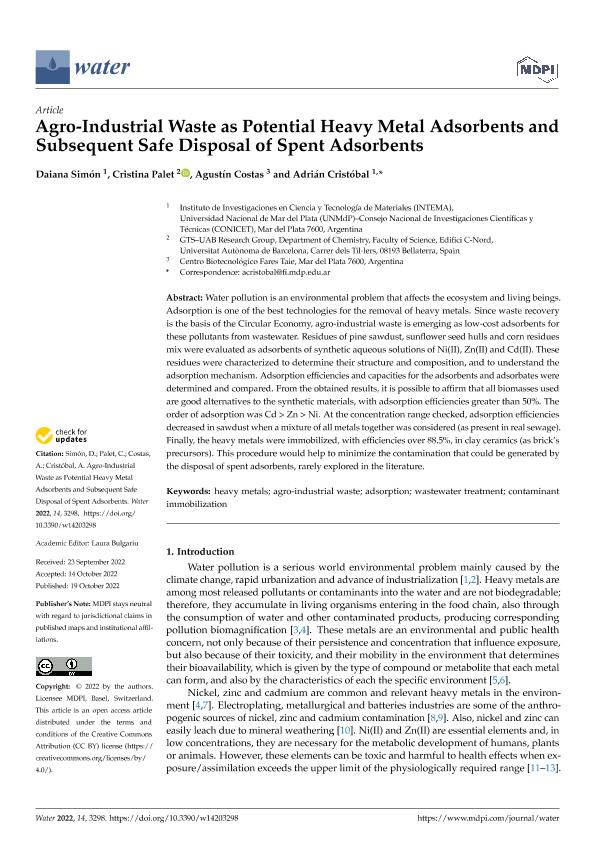Artículo
Agro-Industrial Waste as Potential Heavy Metal Adsorbents and Subsequent Safe Disposal of Spent Adsorbents
Fecha de publicación:
10/2022
Editorial:
Multidisciplinary Digital Publishing Institute
Revista:
Water
ISSN:
2073-4441
Idioma:
Inglés
Tipo de recurso:
Artículo publicado
Clasificación temática:
Resumen
Water pollution is an environmental problem that affects the ecosystem and living beings. Adsorption is one of the best technologies for the removal of heavy metals. Since waste recovery is the basis of the Circular Economy, agro-industrial waste is emerging as low-cost adsorbents for these pollutants from wastewater. Residues of pine sawdust, sunflower seed hulls and corn residues mix were evaluated as adsorbents of synthetic aqueous solutions of Ni(II), Zn(II) and Cd(II). These residues were characterized to determine their structure and composition, and to understand the adsorption mechanism. Adsorption efficiencies and capacities for the adsorbents and adsorbates were determined and compared. From the obtained results, it is possible to affirm that all biomasses used are good alternatives to the synthetic materials, with adsorption efficiencies greater than 50%. The order of adsorption was Cd > Zn > Ni. At the concentration range checked, adsorption efficiencies decreased in sawdust when a mixture of all metals together was considered (as present in real sewage). Finally, the heavy metals were immobilized, with efficiencies over 88.5%, in clay ceramics (as brick’s precursors). This procedure would help to minimize the contamination that could be generated by the disposal of spent adsorbents, rarely explored in the literature.
Archivos asociados
Licencia
Identificadores
Colecciones
Articulos(INTEMA)
Articulos de INST.DE INV.EN CIENCIA Y TECNOL.MATERIALES (I)
Articulos de INST.DE INV.EN CIENCIA Y TECNOL.MATERIALES (I)
Citación
Simón, Daiana Lucía; Palet, Cristina; Costas, Agustín; Cristobal, Adrian Alberto; Agro-Industrial Waste as Potential Heavy Metal Adsorbents and Subsequent Safe Disposal of Spent Adsorbents; Multidisciplinary Digital Publishing Institute; Water; 14; 20; 10-2022; 1-19
Compartir
Altmétricas




